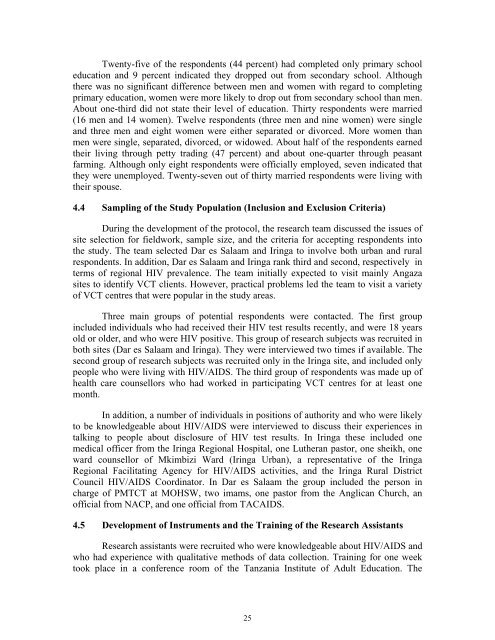social context of disclosing hiv test results: hiv testing in tanzania
social context of disclosing hiv test results: hiv testing in tanzania
social context of disclosing hiv test results: hiv testing in tanzania
Create successful ePaper yourself
Turn your PDF publications into a flip-book with our unique Google optimized e-Paper software.
Twenty-five <strong>of</strong> the respondents (44 percent) had completed only primary school<br />
education and 9 percent <strong>in</strong>dicated they dropped out from secondary school. Although<br />
there was no significant difference between men and women with regard to complet<strong>in</strong>g<br />
primary education, women were more likely to drop out from secondary school than men.<br />
About one-third did not state their level <strong>of</strong> education. Thirty respondents were married<br />
(16 men and 14 women). Twelve respondents (three men and n<strong>in</strong>e women) were s<strong>in</strong>gle<br />
and three men and eight women were either separated or divorced. More women than<br />
men were s<strong>in</strong>gle, separated, divorced, or widowed. About half <strong>of</strong> the respondents earned<br />
their liv<strong>in</strong>g through petty trad<strong>in</strong>g (47 percent) and about one-quarter through peasant<br />
farm<strong>in</strong>g. Although only eight respondents were <strong>of</strong>ficially employed, seven <strong>in</strong>dicated that<br />
they were unemployed. Twenty-seven out <strong>of</strong> thirty married respondents were liv<strong>in</strong>g with<br />
their spouse.<br />
4.4 Sampl<strong>in</strong>g <strong>of</strong> the Study Population (Inclusion and Exclusion Criteria)<br />
Dur<strong>in</strong>g the development <strong>of</strong> the protocol, the research team discussed the issues <strong>of</strong><br />
site selection for fieldwork, sample size, and the criteria for accept<strong>in</strong>g respondents <strong>in</strong>to<br />
the study. The team selected Dar es Salaam and Ir<strong>in</strong>ga to <strong>in</strong>volve both urban and rural<br />
respondents. In addition, Dar es Salaam and Ir<strong>in</strong>ga rank third and second, respectively <strong>in</strong><br />
terms <strong>of</strong> regional HIV prevalence. The team <strong>in</strong>itially expected to visit ma<strong>in</strong>ly Angaza<br />
sites to identify VCT clients. However, practical problems led the team to visit a variety<br />
<strong>of</strong> VCT centres that were popular <strong>in</strong> the study areas.<br />
Three ma<strong>in</strong> groups <strong>of</strong> potential respondents were contacted. The first group<br />
<strong>in</strong>cluded <strong>in</strong>dividuals who had received their HIV <strong>test</strong> <strong>results</strong> recently, and were 18 years<br />
old or older, and who were HIV positive. This group <strong>of</strong> research subjects was recruited <strong>in</strong><br />
both sites (Dar es Salaam and Ir<strong>in</strong>ga). They were <strong>in</strong>terviewed two times if available. The<br />
second group <strong>of</strong> research subjects was recruited only <strong>in</strong> the Ir<strong>in</strong>ga site, and <strong>in</strong>cluded only<br />
people who were liv<strong>in</strong>g with HIV/AIDS. The third group <strong>of</strong> respondents was made up <strong>of</strong><br />
health care counsellors who had worked <strong>in</strong> participat<strong>in</strong>g VCT centres for at least one<br />
month.<br />
In addition, a number <strong>of</strong> <strong>in</strong>dividuals <strong>in</strong> positions <strong>of</strong> authority and who were likely<br />
to be knowledgeable about HIV/AIDS were <strong>in</strong>terviewed to discuss their experiences <strong>in</strong><br />
talk<strong>in</strong>g to people about disclosure <strong>of</strong> HIV <strong>test</strong> <strong>results</strong>. In Ir<strong>in</strong>ga these <strong>in</strong>cluded one<br />
medical <strong>of</strong>ficer from the Ir<strong>in</strong>ga Regional Hospital, one Lutheran pastor, one sheikh, one<br />
ward counsellor <strong>of</strong> Mkimbizi Ward (Ir<strong>in</strong>ga Urban), a representative <strong>of</strong> the Ir<strong>in</strong>ga<br />
Regional Facilitat<strong>in</strong>g Agency for HIV/AIDS activities, and the Ir<strong>in</strong>ga Rural District<br />
Council HIV/AIDS Coord<strong>in</strong>ator. In Dar es Salaam the group <strong>in</strong>cluded the person <strong>in</strong><br />
charge <strong>of</strong> PMTCT at MOHSW, two imams, one pastor from the Anglican Church, an<br />
<strong>of</strong>ficial from NACP, and one <strong>of</strong>ficial from TACAIDS.<br />
4.5 Development <strong>of</strong> Instruments and the Tra<strong>in</strong><strong>in</strong>g <strong>of</strong> the Research Assistants<br />
Research assistants were recruited who were knowledgeable about HIV/AIDS and<br />
who had experience with qualitative methods <strong>of</strong> data collection. Tra<strong>in</strong><strong>in</strong>g for one week<br />
took place <strong>in</strong> a conference room <strong>of</strong> the Tanzania Institute <strong>of</strong> Adult Education. The<br />
25

















